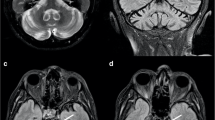Abstract
Objective
To compare diffusion tensor imaging (DTI) of the kidneys and its derived parameters in children with autosomal recessive polycystic kidney disease (ARPKD) versus healthy controls.
Methods
In a prospective IRB-approved study, we evaluated the use of DTI to compare kidney parenchyma FA values in healthy controls (age-matched children with no history of renal disease) versus patients with ARPKD. A 20-direction DTI with b-values of b = 0 s/mm2 and b = 400 s/mm2 was used to acquire data in coronal direction using a fat-suppressed spin-echo echo-planar sequence. Diffusion Toolkit and TrackVis were used for analysis and segmentation. TrackVis was used to draw regions of interest (ROIs) covering the entire volume of the renal parenchyma, excluding the collecting system. Fibers were reconstructed using a deterministic fiber tracking algorithm. The FA values based on the ROI data, mean length, and volume of the tracks based on the fiber tracking data were recorded.
Results
Eight healthy controls (mean age = 12.9 years ± 4.0; 1/8 males) and six ARPKD participants (mean age = 13.8 years ± 8.5; 5/6 males) were included in the study. Compared to healthy controls, patients with ARPKD had significantly lower FA values (0.33 ± 0.03 vs. 0.25 ± 0.02, p = 0.002) and mean track length (16.73 ± 3.43 vs. 11.61 ± 1.29 mm, p = 0.005).
Conclusion
DTI of the kidneys shows significantly lower FA values and mean track length in children and young adults with ARPKD compared to normal subjects. DTI of the kidney offers a novel approach for characterizing renal disease based on changes in diffusion anisotropy and kidney structure.



Similar content being viewed by others
References
Dell, K.M., The spectrum of polycystic kidney disease in children. Adv Chronic Kidney Dis, 2011. 18(5): p. 339-47.
Hartung, E.A. and L.M. Guay-Woodford, Autosomal recessive polycystic kidney disease: a hepatorenal fibrocystic disorder with pleiotropic effects. Pediatrics, 2014. 134(3): p. e833-45.
Guay-Woodford, L.M., et al., Consensus expert recommendations for the diagnosis and management of autosomal recessive polycystic kidney disease: report of an international conference. J Pediatr, 2014. 165(3): p. 611-7.
Wang, X., et al., Effectiveness of vasopressin V2 receptor antagonists OPC-31260 and OPC-41061 on polycystic kidney disease development in the PCK rat. J Am Soc Nephrol, 2005. 16(4): p. 846-51.
Masyuk, T.V., et al., Pasireotide is more effective than octreotide in reducing hepatorenal cystogenesis in rodents with polycystic kidney and liver diseases. Hepatology, 2013. 58(1): p. 409-21.
Sweeney, W.E., P. Frost, and E.D. Avner, Tesevatinib ameliorates progression of polycystic kidney disease in rodent models of autosomal recessive polycystic kidney disease. World J Nephrol, 2017. 6(4): p. 188-200.
Grantham, J.J., et al., Volume progression in polycystic kidney disease. N Engl J Med, 2006. 354(20): p. 2122-30.
Torres, V.E., et al., Multicenter, open-label, extension trial to evaluate the long-term efficacy and safety of early versus delayed treatment with tolvaptan in autosomal dominant polycystic kidney disease: the TEMPO 4:4 Trial. Nephrol Dial Transplant, 2018. 33(3): p. 477-489.
Yu, A.S.L., et al., Baseline total kidney volume and the rate of kidney growth are associated with chronic kidney disease progression in Autosomal Dominant Polycystic Kidney Disease. Kidney Int, 2018. 93(3): p. 691-699.
Gunay-Aygun, M., et al., Correlation of kidney function, volume and imaging findings, and PKHD1 mutations in 73 patients with autosomal recessive polycystic kidney disease. Clin J Am Soc Nephrol, 2010. 5(6): p. 972-84.
Jaimes, C., et al., Diffusion tensor imaging and tractography of the kidney in children: feasibility and preliminary experience. Pediatr Radiol, 2014. 44(1): p. 30-41.
Bergmann, C., et al., Clinical consequences of PKHD1 mutations in 164 patients with autosomal-recessive polycystic kidney disease (ARPKD). Kidney Int, 2005. 67(3): p. 829-48.
Hagmann, P., et al., Understanding diffusion MR imaging techniques: from scalar diffusion-weighted imaging to diffusion tensor imaging and beyond. Radiographics, 2006. 26 Suppl 1: p. S205-23.
Kim, H.K., et al., Magnetic resonance imaging of pediatric muscular disorders: recent advances and clinical applications. Radiol Clin North Am, 2013. 51(4): p. 721-42.
Radhakrishnan, R., et al., Reduced Field of View Diffusion-Weighted Imaging in the Evaluation of Congenital Spine Malformations. J Neuroimaging, 2016. 26(3): p. 273-7.
Serai, S.D., et al., Putting it all together: established and emerging MRI techniques for detecting and measuring liver fibrosis. Pediatr Radiol, 2018. 48(9): p. 1256-1272.
Zhang, J.L., et al., New magnetic resonance imaging methods in nephrology. Kidney Int, 2014. 85(4): p. 768-78.
Mori, S. and P.C. van Zijl, Fiber tracking: principles and strategies - a technical review. NMR Biomed, 2002. 15(7-8): p. 468-80.
Hueper, K., et al., Diffusion-Weighted imaging and diffusion tensor imaging detect delayed graft function and correlate with allograft fibrosis in patients early after kidney transplantation. J Magn Reson Imaging, 2016. 44(1): p. 112-21.
Schwartz, G.J., et al., New equations to estimate GFR in children with CKD. J Am Soc Nephrol, 2009. 20(3): p. 629-37.
Levey, A.S., et al., A new equation to estimate glomerular filtration rate. Ann Intern Med, 2009. 150(9): p. 604-12.
Feng, Q., et al., DTI for the assessment of disease stage in patients with glomerulonephritis--correlation with renal histology. Eur Radiol, 2015. 25(1): p. 92-8.
Gaudiano, C., et al., Diffusion tensor imaging and tractography of the kidneys: assessment of chronic parenchymal diseases. Eur Radiol, 2013. 23(6): p. 1678-85.
Notohamiprodjo, M., et al., Diffusion tensor imaging of the kidney with parallel imaging: initial clinical experience. Invest Radiol, 2008. 43(10): p. 677-85.
Author information
Authors and Affiliations
Corresponding author
Ethics declarations
Funding
This work was partly funded by NIH grant number 5K23DK109203 (National Institutes of Health/NIDDK), PI: Erum Hartung.
Additional information
Publisher's Note
Springer Nature remains neutral with regard to jurisdictional claims in published maps and institutional affiliations.
Rights and permissions
About this article
Cite this article
Serai, S.D., Otero, H.J., Calle-Toro, J.S. et al. Diffusion tensor imaging of the kidney in healthy controls and in children and young adults with autosomal recessive polycystic kidney disease. Abdom Radiol 44, 1867–1872 (2019). https://doi.org/10.1007/s00261-019-01933-4
Published:
Issue Date:
DOI: https://doi.org/10.1007/s00261-019-01933-4




